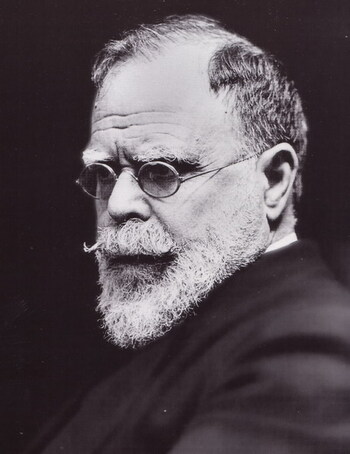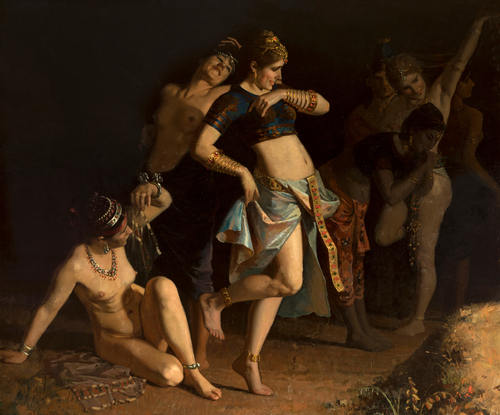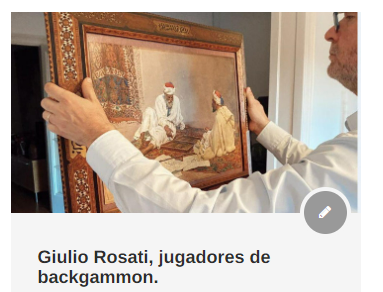The orientalist dream of Francisco Pradilla
The museum quality of “Danza de odaliscas” reveals the best version of Francisco Pradilla’s orientalist production.
The European colonial expansion in North Africa during the 19th century was decisive in the desire of many artists to travel and explore an unknown world. The representation of its landscapes, customs and conflicts gave rise to the so-called orientalist painting, a genre with its own personality within nineteenth-century art that was passionately cultivated by the great masters of the time.
The irruption of orientalism as a fully recognized genre finds its origin during Romanticism which, like medieval historicism, meant an escape from reality endowed with a certain mythification. Artists, attracted by the exotic and distant, represented the oriental world through a prism dominated by fantasy and evocative character. which characterized the many stories about the lands of Mediterranean Africa and the Near East that, like those of Francis Burton, Gustav Flaubert or Gerard de Nerval, among others, proliferated in literature. In fact, following the Napoleonic campaigns, the Western imaginary was nourished by the glories of these old empires whose conquest was represented in multiple scenes symbolizing the power and superiority of the West over the East.
One of the most powerful images that penetrated bourgeois taste and, therefore, the art market was undoubtedly that of the odalisque. Artists such as Ingres or Delacroix dedicated part of their production to these sensual slaves of the Turkish harem who, given to the lowest passions, became in one of the great myths that the history of art has created. Proof of this are the images that immediately come to mind when we think of their figure, imagining them as exuberant women dancing sensually or lying on the couch of the harem. Whether nude or adorned with exotic clothing and jewelry, the figure of the of the odalisque symbolized the dreamed, mythologized and therefore misunderstood image of the oriental world and in particular of women, thus contributing to the creation of archetypes that have survived to the present day, such as that of the femme fatale.. The iconographic model established in nineteenth-century French painting by Jean Auguste Dominique Ingres and Eugène Delacroix is, therefore, the result of an exoticized and eroticized vision where the female body represents the desire of the West to escape from its reality to immerse itself fully in the oriental reverie that they wanted to recreate.

At the national levelWhile it is true that all the clichés and mythologies that had shaped European romantic culture were incorporated, there was a desire to project a less fanciful vision of Moorish culture. Mariano Fortuny began the path that later generations, such as our protagonist Francisco Pradilla, took as a reference. In fact, Pradilla’s orientalist vision will be marked both by his trips to North Africa and by the years he spent in the region. could share with Mariano Fortuny during his stay in Rome, being in the last year of his pension in the Italian capital when he made the monumental work in bidding “Dance of Odalisques”.. In it, Pradilla takes as a model one of the most recurrent scenes of this typology, showing a group of odalisques dancing half-naked to the beat of a musical instrument, giving light to an apotheosic exercise of technical mastery both at a chromatic and draftsmanship level.
As we can see in it, the painting of this period will be dominated by the realistic tone that emerges both in the expressive intensity of the characters, as well as in the execution of the details and the successful light treatment. In this aspect, the Aragonese painter is heir to the preciosity and dramatic effects of chiaroscuro practiced by his French predecessors, but also, and very notably, to the imprint that Mariano Fortuny left on the entire generation that immediately followed him, and he was even considered the most important supporter of the young Pradilla’s time.
The warm light that enters the scene from the right side to illuminate the women in the foreground, contrasts with the darkness of a background from which a male figure emerges to observe them as they surrender to the sensuality of the dance. This play of light, together with the swaying movements of the female bodies and the exchange of glances between them, endow the composition with a very sharp rhythmic sense full of dynamism. It should also be noted that, unlike other representations starring odalisques, Pradilla here frees them from the harem. The scene is then transferred to a nocturnal exterior in what appears to be a natural setting, which only accentuates the mysterious character of this type of scene.
In fact, As specialists in his work maintain, “Odalisque Dance” is related to other orientalist paintings made in the same year which, like the “Odalisque” acquired by the Goya Museum in 2021, show us one of the women who are the protagonists of our painting. dressed in typical Moorish garb and immersed with a pair of musical instruments in a similar nocturnal environment. This fact has given rise to a more than reasonable hypothesis according to which the artist was then considering the possibility of presenting an orientalist theme of this kind to the National Exhibition of Fine Arts of 1887, which he finally discarded in favor of a historicist theme.
Be that as it may, there is an unappealable certainty of the portentous talent that Pradilla showed since his beginnings and that now, thanks to the tender of “Danza de Odaliscas”, we can enjoy in all its splendor, reliving the orientalist dream that the artist imagined.






